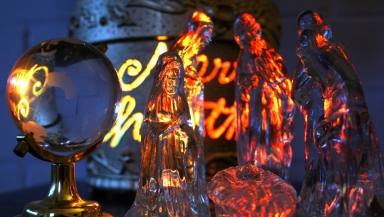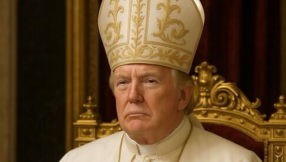
Description: Gold, Frankincense, and Myrrh. Three incredibly valuable commodities. Nothing is known about exactly how much of each was given, but since the Magi were offering them as royal tribute gifts, we can infer it was a fairly substantial amount.
Gold (atomic number 79 on the periodic table) was then, as it is today, a marker of currency value. In the case of the Magi, being most likely from somewhere in Persia, or another area where Zoroastrianism was dominant, the gold they received would have either been via trade (although unlikely, as if it was a gift it would not have been in coin form) or it had come in mined from the Ural-Altai region of central Asia, or the Gulf of 'Aquaba, two of the closest well excavated gold mining sites of the time.
The etymology of the word Frankincense tells you what kind of valuable product we're talking about. It comes from an old French word "franc encens" which literally means "High Quality Incense". It is a resin made from the sap of certain trees from the Burseraceae family. Specifically, the Olibanum tree (because of its use, also known as the Frankincense tree) which is native to the Arabian peninsula and the horn of Africa.
It takes 8 to 10 years before a planted tree begins producing this resin. Despite being hardy enough to survive great storms and to seemingly grow out of solid rock, the trees are also quite delicate (the bark has the texture of paper, making it fragile and easy to remove). Therefore all the collecting must be done by hand. Not only that, but the quality of the resin extracted (individual hardened chunks of which are called tears) must be hand inspected before being deemed of suitable quality to be sold.
The number of expert craftsmen involved in harvesting, selecting, and preserving this substance begins to give you some idea of how much it would have cost. Today solid resin can be sold for £37.50 a kilo, but that is with far more workers and far better equipment than would have been available at the time. 2,000 years ago, the value could have been dozens of times that.
Myrrh is also a resin, but is presented most often in its liquid form as a fragrant oil. The tree it comes from, Commiphora myrrha, is also a member of the Burseraceae family. It is also native to the Arabian peninsula, but has reached further down into Africa, as far west as Ethiopia and as far south as Kenya. At certain points in history myrrh was so valuable its cost per kilo would have been the same as gold.
Significance: On the general level, there is the significance of the behaviour of the Magi, in bringing these rare and valuable items. This proves from the very beginning that Jesus's birth was thought of as something special. But working down to the more specific, although the Bible never explicitly explains this, there is the definite suggestion that the nature of each of these gifts carries a great symbolic significance about who Jesus was and what he would do.
First Sighting: The gifts, much like the Magi themselves and the star, are only referenced once in the Nativity accounts. Specifically, they come up in Matthew 2 verse 11.
"On coming to the house, they saw the child with his mother Mary, and they bowed down and worshipped him. Then they opened their treasures and presented him with gifts of gold, frankincense and myrrh."
Prophecies linked to the giving of gifts help explain why the Magi have so often been reported as kings.
"May the kings of Tarshish and of distant shores bring tribute to him, May the kings of Sheba and Seba present him with gifts… May gold from Sheba be given to him." (Psalm 72, Verses 10 and 15)
"the ships of Tarshish, bringing your children from afar, with their silver and gold, to the honour of the Lord your God, the Holy One of Israel, for he has endowed you with splendour." (Isaiah 60, Verse 9)
There are also some interesting mentions of the items throughout the Old Testament, giving clues as to their meaning. One of the lesser known of these is that myrrh was used as a purifying oil, as is mentioned in the book of Esther.
"Before a young woman's turn came to go in to King Xerxes, she had to complete twelve months of beauty treatments prescribed for the women, six months with oil of myrrh and six with perfumes and cosmetics." (Esther 2, Verse 12)
Frankincense is mentioned only three times in the Bible. Once in Exodus, once in Matthew, and once again in Revelation. It is very clear from the Exodus reference that it has great significance.
"Then the Lord said to Moses, 'Take fragrant spices – gum resin, onycha and galbanum – and pure frankincense, all in equal amounts, and make a fragrant blend of incense, the work of a perfumer. It is to be salted and pure and sacred. Grind some of it to powder and place it in front of the ark of the covenant law in the tent of meeting, where I will meet with you. It shall be most holy to you. Do not make any incense with this formula for yourselves; consider it holy to the Lord. Whoever makes incense like it to enjoy its fragrance must be cut off from their people.'" (Exodus 30, Verses 34-38)
Explanation: The three gifts were undoubtedly objects of incredible value. Theories abound about the exact meaning behind them, although none is specifically mentioned in the Bible. However, the most common understanding is that they were symbols.
Gold is purely a sign of value and wealth, but in the ancient world it was also one of kingship or royalty more generally.
Frankincense, as the Exodus verses explains, was something of divine note. When it was burned, the sweet smelling white smoke was often considered a symbol of the prayers of the Jewish people. It was used in extremely important ceremonies, being burned as an offering in the Tabernacle every morning and night. Malachi 1:11 points to it having particular significant as a sign of someone being in the name of God, not just to the Jews but also the Gentiles.
"…My name will be great among the nations, from where the sun rises to where it sets. In every place incense and pure offerings will be brought to me, because my name will be great among the nations,' says the Lord Almighty." (Malachi 1, Verse 11)
Myrrh is perhaps the most ominous. Although as an oil it was most often used as a perfume, it was widely known to be used as an scented embalming oil (particularly by the ancient Egyptians). To give this to a child is rather like turning up at a baby shower with a ready-to-be-engraved headstone as a gift. However, there is a dual meaning here. It was also a key ingredient of the anointing oil. It was used very often to symbolise the authority and holiness of priests, kings, and even the Tabernacle itself. The fragrance in the oil was used for keeping away the stench of decaying death, but it also gave the mark of cleansing holiness.
In conclusion, gold can be taken to symbolise royalty and kingship; frankincense divinity and holiness; and myrrh suffering and death. The carol "we three kings" comments on this in its last verse, describing the gifts as symbolising "Glorious now behold Him arise/King and God and sacrifice".
This symbolism was once again first proposed by Origen in his book Contra Celsum, where he wrote "gold, as to a king; myrrh, as to one who was mortal; and incense, as to a God".













